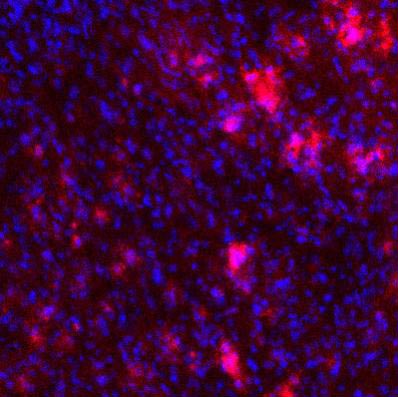Potential Alzheimer's drug prevents abnormal blood clots in the brain

New experiments in Sidney Strickland's Laboratory of Neurobiology and Genetics at Rockefeller University have identified a compound that might halt the progression of Alzheimer's by interfering with the role amyloid-β, a small protein that forms plaques in Alzheimer's brains, plays in the formation of blood clots. This work is highlighted in the July issue of Nature Reviews Drug Discovery.
For more than a decade, potential Alzheimer's drugs have targeted amyloid-β, but, in clinical trials, they have either failed to slow the progression of the disease or caused serious side effects. However, by targeting the protein's ability to bind to a clotting agent in blood, the work in the Strickland lab offers a promising new strategy, according to the highlight, which will be published in print on July 1.
This latest study builds on previous work in Strickland's lab showing amyloid-β can interact with fibrinogen, the clotting agent, to form difficult-to-break-down clots that alter blood flow, cause inflammation and choke neurons.
“Our experiments in test tubes and in mouse models of Alzheimer's showed the compound, known as RU-505, helped restore normal clotting and cerebral blood flow. But the big pay-off came with behavioral tests in which the Alzheimer's mice treated with RU-505 exhibited better memories than their untreated counterparts,” Strickland says. “These results suggest we have found a new strategy with which to treat Alzheimer's disease.”
RU-505 emerged from a pack of 93,716 candidates selected from libraries of compounds, the researchers write in the June issue of the Journal of Experimental Medicine. Hyung Jin Ahn, a research associate in the lab, examined these candidates with a specific goal in mind: Find one that interferes with the interaction between fibrinogen and amyloid-β.
In a series of tests that began with a massive, automated screening effort at Rockefeller's High Throughput Resource Center, Ahn and colleagues winnowed the 93,000 contenders to five. Then, test tube experiments whittled the list down to one contender: RU-505, a small, synthetic compound. Because RU-505 binds to amyloid-β and only prevents abnormal blood clot formation, it does not interfere with normal clotting. It is also capable of passing through the blood-brain barrier.
“We tested RU-505 in mouse models of Alzheimer's disease that over-express amyloid- β and have a relatively early onset of disease. Because Alzheimer's disease is a long-term, progressive disease, these treatments lasted for three months,” Ahn says. “Afterward, we found evidence of improvement both at the cellular and the behavioral levels.”
The brains of the treated mice had less of the chronic and harmful inflammation associated with the disease, and blood flow in their brains was closer to normal than that of untreated Alzheimer's mice. The RU-505-treated mice also did better when placed in a maze. Mice naturally want to escape the maze, and are trained to recognize visual cues to find the exit quickly. Even after training, Alzheimer's mice have difficulty in exiting the maze. After these mice were treated with RU-505, they performed much better.
“While the behavior and the brains of the Alzheimer's mice did not fully recover, the three-month treatment with RU-505 prevents much of the decline associated with the disease,” Strickland says.
The researchers have begun the next steps toward developing a human treatment. Refinements to the compound are being supported by the Robertson Therapeutic Development Fund and the Tri-Institutional Therapeutic Discovery Institute. As part of a goal to help bridge critical gaps in drug discovery, these initiatives support the early stages of drug development, as is being done with RU-505.
“At very high doses, RU-505 is toxic to mice and even at lower doses it caused some inflammation at the injection site, so we are hoping to find ways to reduce this toxicity, while also increasing RU-505's efficacy so smaller doses can accomplish similar results,” Ahn says.
Media Contact
All latest news from the category: Health and Medicine
This subject area encompasses research and studies in the field of human medicine.
Among the wide-ranging list of topics covered here are anesthesiology, anatomy, surgery, human genetics, hygiene and environmental medicine, internal medicine, neurology, pharmacology, physiology, urology and dental medicine.
Newest articles

Superradiant atoms could push the boundaries of how precisely time can be measured
Superradiant atoms can help us measure time more precisely than ever. In a new study, researchers from the University of Copenhagen present a new method for measuring the time interval,…

Ion thermoelectric conversion devices for near room temperature
The electrode sheet of the thermoelectric device consists of ionic hydrogel, which is sandwiched between the electrodes to form, and the Prussian blue on the electrode undergoes a redox reaction…

Zap Energy achieves 37-million-degree temperatures in a compact device
New publication reports record electron temperatures for a small-scale, sheared-flow-stabilized Z-pinch fusion device. In the nine decades since humans first produced fusion reactions, only a few fusion technologies have demonstrated…





















